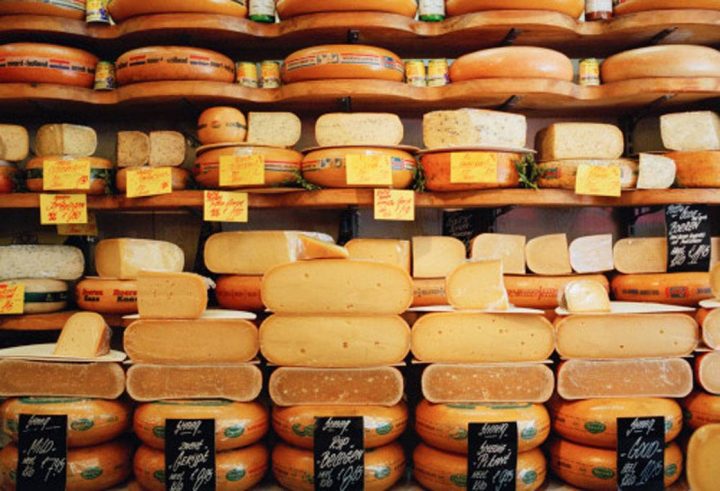LONDON, Ont. – Most Canadians would probably admit to being caseophiles if they knew what it meant.

Caseophile is just a five-dollar word for cheese lover, from the Latin “caseus,” meaning cheese, and although we’re well behind countries such as France, where annual per capita cheese consumption tops 26 kilograms (57 pounds), Canadians still manage to put away more than 12 kilograms (26 pounds) of cheese a year each.
That’s a lot of cheese.
Quebec is the biggest producer of cheese, followed by Ontario, but there are cheesemakers in every province who produced more than 137.7 million kilograms (303 million pounds) and more than 1,050 types of cheese in 2011, according to the Canadian Dairy Commission.
Cheddar and mozzarella account for 61 per cent of that production, with their manufacture dominated by large industrial firms. But more and more consumers are turning to specialty or artisanal cheeses made by small, hands-on producers.
“More Canadians are wanting to know where their food is coming from, learning more about it, so that is bringing a lot of interest to our speciality cheesemakers,” says Debbie Levy of Mississauga, Ont. She is a graduate of the Cheese Education Guild, the first cheese school dedicated to cheese appreciation in Canada, and works for Dairy Farmers of Canada.
“Consumers want to learn about cheeses; they want to know about the milk source and how they’re made.”
Ruth Klahsen of Stratford, Ont., is one of those producers of artisanal cheeses. “I was a chef who had a mid-life crisis,” she offers as the reason for starting Monforte Dairy 10 years ago, and she is passionate about her work, although she can’t fully explain why.
“There’s just always been something about ruminants and milk, it’s beautiful, but I don’t know other than that. There’s just something about it that works for me.”
Monforte makes about 30 kinds of cheese from cow, sheep, goat and domestic water buffalo milk. They are sold mainly at the dairy and farmers markets, but Klahsen also supplies high-end restaurants, opened the Monforte on Wellington restaurant in Stratford and has a Toronto store-front operation.
She agrees the artisanal market is small yet expanding, but fears the recent trade agreement between Canada and the European Union “will put the stop to that.” The agreement would double the amount of European cheese allowed into Canada to around 30 million kilograms (66 million pounds) a year.
“I’m worried about the future,” Klahsen says. “They are mostly French industrial cheeses, but they are done in an artisan style and they do a very good job. They can sell it in Loblaws for less than my cost of production.”
Her first cheese was Toscano, made from sheep’s milk. It is a firm cheese with a natural, coarsely textured rind and warmly coloured interior, somewhat related to Italian pecorino.
“We do a lot of cheeses that people can cook with, like halloumi and ricotta. But I also want cheeses that are good enough for people to sit down and eat.”
Klahsen says there are always trends in cheesemaking and one of the latest is the use of ash.
It started about five years ago when a few chefs started using ashes from burned food, wood or hay on, in or to cook certain food.
“Now everything has ash on it,” Klahsen says.
In cheesemaking, ash is used to form a natural protective coating and add a vein of flavour to a cheese.
“The ash reduces the acidity so it sweetens your curd; it ripens it up.”
She says her customers will try new things “because we deal direct and we make them taste everything. They’re up for the ride.”
In Canada, cheeses are classified in one of six categories according to the moisture content. Most Canadian cheeses fall into the firm (cheddar and Swiss, for example), soft (brie, Camembert, feta) or semi-soft (mozzarella, havarti, Gouda) categories.
The other categories are hard, blue-veined and fresh, meaning cheese which has not been ripened. Bocconcini is an example of fresh cheese.
Goat cheese, or chevre, softens when exposed to heat but does melt in the same way many cow’s milk cheeses do. It is used to make a variety of cheeses.
Sheep’s milk has more fat and protein than cow’s milk and because it is richer, it generally takes less sheep’s milk to make a kilogram of cheese than cow’s milk. Cheese made with sheep’s milk tends to have a nutty and sweet flavour.
Water buffalo milk is primarily used to make variations of mozzarella.
Although many types of Canadian cheese have won international awards, the country is best known for cheddar.
“In the late 1800s, cheddar cheese was second only to timber in our exports,” says Levy.
And in 1986, a Canadian cheddar was named the “world’s finest cheese” at an international competition in Wisconsin.

Comments